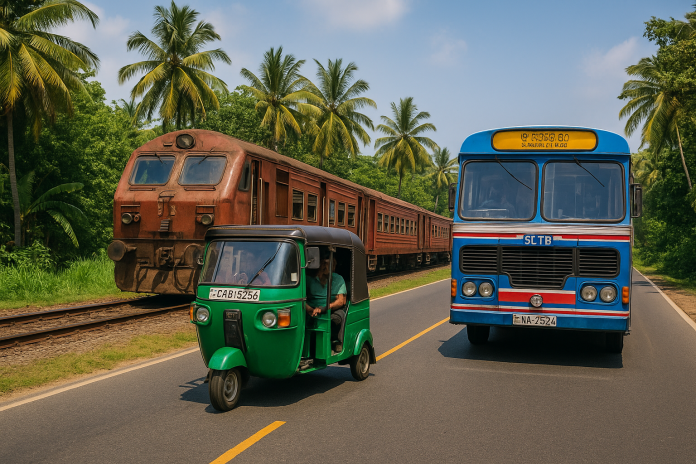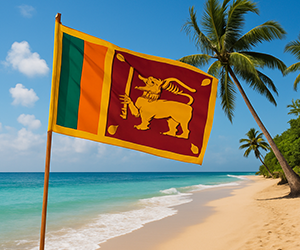1. Introduction to Transportation in Sri Lanka
Sri Lanka, an island nation rich in cultural heritage and natural beauty, boasts a diverse and evolving transportation network that caters to both locals and tourists. With bustling cities, scenic hill country, and remote rural villages, the country offers multiple modes of transport to navigate its varied landscapes. From ancient railway lines still in operation to modern expressways and convenient ride-hailing apps, getting around Sri Lanka is an adventure in itself.
Transportation plays a critical role in Sri Lanka’s economic development, tourism industry, and daily life. Whether you’re commuting within Colombo or traveling across the country, understanding the available transport options can enhance your experience. In this guide, we explore the major types of transportation in Sri Lanka and how to make the most of them.
2. Road Transportation in Sri Lanka
2.1 Buses
Buses are the most common and affordable mode of transportation for locals. There are two main types: state-owned buses operated by the Sri Lanka Transport Board (SLTB or CTB) and private buses. SLTB buses are generally more reliable and follow fixed schedules, while private buses can be more frequent but less organized. These buses operate on both short and long-distance routes, connecting cities, towns, and even remote villages.
Intercity buses, including air-conditioned express buses, connect major cities such as Colombo, Kandy, Galle, and Jaffna. The Southern Expressway (E01), Katunayake Expressway (E03), and the Central Expressway (E04) have significantly improved travel times, enabling more comfortable and quicker transit options for both locals and tourists. Some buses have onboard entertainment and Wi-Fi, making long journeys more enjoyable.
- Keywords: Sri Lanka bus service, SLTB bus, express bus Sri Lanka
2.2 Tuk-Tuks (Three-Wheelers)
Tuk-tuks are an iconic and widely used form of transport in Sri Lanka. These three-wheeled vehicles are perfect for short distances and navigating narrow streets. They are especially useful for last-mile connectivity in towns and cities where buses or taxis may not be available.
While tuk-tuks are available throughout the country, it is crucial to negotiate the fare before starting the ride, especially in tourist areas. In major cities like Colombo and Kandy, some tuk-tuks are equipped with meters. Alternatively, use ride-hailing apps like PickMe or Uber for metered pricing and more transparent transactions.
- Keywords: tuk tuk Sri Lanka, three-wheeler taxi Sri Lanka, PickMe app
2.3 Taxis and Ride-Hailing Apps
Taxis are readily available in major cities and can be booked via phone or app. Ride-hailing platforms like Uber, PickMe, and Bolt offer services ranging from tuk-tuks to cars and vans, making it easy for travelers to get around.
These services offer fare transparency, real-time tracking, and safety features, which makes them popular among both tourists and locals. Taxis can also be hired on a daily basis for sightseeing or business travel.
- Keywords: taxi Sri Lanka, Uber Sri Lanka, PickMe Sri Lanka
2.4 Private Vehicle Hire
Tourists often opt to rent cars or motorbikes for added flexibility and freedom. You can choose between self-driving and hiring a vehicle with a driver. Major international car rental companies and local providers offer these services. Self-driving is ideal for those familiar with local traffic rules and road conditions.
A temporary Sri Lankan driving permit is required for foreigners, which can be obtained through the Automobile Association of Ceylon (AAC) or approved agencies. Motorbike rentals are popular along the southern and eastern coasts, especially among backpackers and surfers.
- Keywords: rent a car Sri Lanka, bike rental Sri Lanka, self-drive car hire
3. Railway Transport in Sri Lanka
The Sri Lanka Railway network is a scenic and budget-friendly way to explore the country. Trains are operated by Sri Lanka Railways, with a history dating back to the British colonial era. The network spans over 1,500 kilometers and connects most major cities and regions.
Popular routes include:
- Colombo to Kandy: A cultural and historical journey through the central hills.
- Kandy to Ella via Nuwara Eliya: A scenic ride through tea plantations and mountain vistas.
- Colombo to Galle and Matara: A coastal route offering views of the Indian Ocean.
- Colombo to Jaffna: A long but culturally rich trip to the north.
Classes include 1st, 2nd, and 3rd, with some offering air conditioning. Observation saloons are available on certain routes for tourists seeking the best views. Reservations are advisable for long journeys, especially in peak seasons.
- Keywords: Sri Lanka train travel, Colombo to Ella train, scenic train Sri Lanka
4. Air Travel in Sri Lanka
Sri Lanka has three international airports and several domestic airstrips:
- Bandaranaike International Airport (CMB): The main gateway located near Colombo.
- Mattala Rajapaksa International Airport (HRI): Serves the southern region.
- Jaffna International Airport (JAF): Connects the north with the rest of the island.
Domestic airlines like Cinnamon Air, FitsAir, and charter operators connect Colombo with destinations like Sigiriya, Batticaloa, and Trincomalee. Seaplanes and helicopter charters are available for luxury travelers heading to resorts or remote areas.
Flying reduces travel time drastically and offers breathtaking aerial views of the island.
- Keywords: Sri Lanka domestic flights, Bandaranaike International Airport, seaplane Sri Lanka
5. Water-Based Transportation
Sri Lanka’s use of water-based transport is limited but growing. Historically, ferries like the Talaimannar to Rameswaram route connected Sri Lanka with India, although these are no longer operational.
Inland waterways such as Madu River, Bentota River, and Negombo Lagoon offer boat safaris and eco-tours. These services are used mainly for leisure and tourism.
In some coastal areas, local fishermen provide boat rides to islands and secluded beaches. Efforts are underway to develop commercial ferry services to enhance connectivity.
- Keywords: ferry Sri Lanka, boat ride Sri Lanka, water transport Sri Lanka
6. Transportation for Tourists: What You Need to Know
Tourists have several transport options depending on their budget and itinerary. While trains offer scenic views, buses are budget-friendly, and private vehicles ensure flexibility.
Key tips:
- Plan ahead: Book tickets for popular trains and flights in advance.
- Use apps: PickMe and Uber are widely used in urban areas.
- Local guides: Hiring a guide or driver who speaks English can be helpful.
- Tourist transport cards: Prepaid cards and QR systems are being piloted to simplify fare payments.
- Health & safety: Always wear seatbelts and helmets where required.
Tourists should also remain cautious when using non-metered tuk-tuks or unlicensed taxis.
- Keywords: tourist transport Sri Lanka, travel tips Sri Lanka, safe transport Sri Lanka
7. Future of Transportation in Sri Lanka
The government is actively investing in infrastructure development to modernize the country’s transportation. Key initiatives include:
- Expressway expansion: New links from Colombo to Kandy, Kurunegala, and Hambantota.
- Colombo Light Rail Transit (LRT): A project aimed at reducing congestion in the capital.
- Eco-friendly transport: Introduction of electric buses, tuk-tuks, and bicycle-sharing systems.
- Smart mobility: Real-time traffic updates, cashless fare systems, and AI-driven transport planning.
These developments aim to create a more efficient, environmentally sustainable, and user-friendly transportation network.
- Keywords: future transport Sri Lanka, expressway projects, eco transport Sri Lanka
8. Challenges in the Sri Lankan Transport Sector
Despite improvements, the transport sector faces several hurdles:
- Urban congestion: Overcrowded roads in cities like Colombo and Kandy.
- Aging infrastructure: Old buses, trains, and stations require upgrades.
- Road safety: High accident rates due to poor driving discipline.
- Fuel crises: Occasional shortages disrupt public and private transport.
Addressing these challenges requires strong governance, public-private partnerships, and citizen engagement.
- Keywords: traffic Sri Lanka, transport problems Sri Lanka, road safety Sri Lanka
9. Regional and Rural Transport Accessibility
Access to transportation in rural Sri Lanka varies greatly. While paved roads reach many villages, public transport frequency can be low. Community initiatives and government efforts have introduced:
- School and medical buses
- Modified tractors and three-wheelers
- Cooperative transport services run by villagers
Such programs are vital for improving livelihoods and connecting rural areas to economic centers.
- Keywords: rural transport Sri Lanka, village transport Sri Lanka, regional travel Sri Lanka
10. Conclusion: Navigating Sri Lanka with Ease
From colorful tuk-tuks and panoramic train rides to express buses and domestic flights, Sri Lanka offers a rich and diverse transportation experience. Each mode has its strengths, catering to different travel needs and preferences.
Understanding the options available empowers travelers to make informed choices. As the country continues to modernize, future transport will likely be greener, smarter, and more inclusive. Whether you’re exploring the vibrant streets of Colombo or the tranquil hills of Ella, Sri Lanka’s transport systems are your gateway to unforgettable adventures.
- Keywords: getting around Sri Lanka, best way to travel in Sri Lanka




